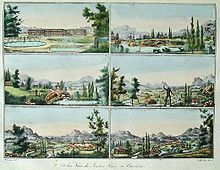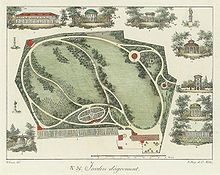Gabriel Thouin
Gabriel Thouin (* 1754 in Paris ; † March 9, 1829 ) was a French garden designer, main representative of the early (romantic) phase of landscape design , at his time one of the most famous garden designers in Europe.
family
He was the son of Jean-André Thouin (? -1764), the 1745 "Jardinier du Cabinet du Roi" (head gardener of the "Royal Garden") was the predecessor of the botanical garden Jardin des Plantes in Paris. The famous botanist André Thouin was his older brother.
life and work
Gabriel Thouin initially apprenticed to his father as a gardener in the "Royal Garden" of Paris and then worked there like his brother. He was an excellent gardener, but it quickly turns out that he was a skilled gardener. In his spare time he draws garden designs.
Soon he was entrusted with a project to enlarge the "Jardin des Plantes". Gabriel worked closely with his brother André. They designed a series of elongated greenhouses to facilitate acclimatization of the many exotic plants that André purposely collected from the expropriated gardens of the nobility and brought to Paris after the French Revolution and during the Napoleonic Wars. However, the project was not implemented due to lack of funds.
Plan raisonné de toutes les espèces de jardins
After being appointed chief inspector of the archbishopric's gardens, he published his first and only book in 1819, the result of 40 years of research and experience. While the brother André describes various cultivation techniques for plants in his book “Cours de culture et de naturalization des végétaux” , Gabriel deals with his famous “Plan raisonné de toutes les espèces de jardins” (“Well thought-out plans for every type of garden”; published for the first time 1819/1820, several reprints) different styles and garden typologies of the 18th century, suggests, so to speak, the environment in which the plants fit from a design point of view. The first two editions are deliberately published in monochrome and in individually available partial deliveries in order to keep the price low and also to enable less well-off readers to purchase. Thouin did not see his work as a theory of garden art, but as a sample book for practical application. Some copies of the first edition were published in 1919, others in 1920. It was not until the third edition in 1838 by another publisher (Huzard) that the sample plans contained therein were colored and a few more plates were added to emphasize the decorative character and make them even more legible .
The third edition of the book comprises a total of 58 plates, the hand-colored lithographs of garden views and plans are mostly made by C. Motte, one by Bermard, based on drawings by Gabriel Thouin.
In his book - dedicated to André for 50 years of meritorious work - Gabriel draws a line from very modest gardens for workers to lavishly equipped facilities for wealthy groups. He also includes examples of exotic foreign gardens, adapted to European conditions.
In his foreword, Gabriel Thouin divides the different garden types into four main groups according to their use: vegetable garden, orchard, botanical or medicinal garden, as well as ornamental gardens. He divides the ornamental gardens into three main directions according to their shape, namely symmetrical gardens, Anglo-Chinese gardens and landscape gardens. These main classes are then further subdivided. He places symmetrical and landscape gardens next to each other in his division, in principle on an equal level, regardless of any aesthetic appreciation. However, the garden examples in the irregular style clearly outnumber them.
The tables are supplemented by specific descriptions and illustrations of designs for every imaginable type of garden. These include projects that were carried out, some by Thouin himself, including the Royal Gardens of the Tuileries , the public areas on the Champs d'Elysée , a proposal that had not been carried out to partially redesign the baroque gardens of Versailles Palace (while retaining the centrally located parts) and its extension by an even larger landscape garden, as well as the extension project for the Jardin des Plantes.
In the foreword to his book, Gabriel Thouin denies the English the merit of introducing the natural style; He claims that the architect Charles Dufresnoy (1611-88), successor to André Le Nôtre , laid out the first model garden in the natural style at the beginning of the 18th century on a plot of land in the Faubourg (suburb) Saint Antoine near Paris and thus created the basic features of the taste later called "English style".
Significance for garden art in German-speaking countries
Peter Joseph Lenné , who initially stayed in Paris after completing his gardening apprenticeship in 1811/12, studied design with Gabriel Thouin (also in botany with André Thouin, as well as in architecture with Jean-Nicholas-Louis Durand ). The typical design of Gabriel Thouin (wide-arched, curved paths and pants-like crossings, extending the planning space to entire landscapes, incorporating industrial architecture and other existing buildings, using exotic plants) influenced the later work of Lenné and his students (“Lenné-Meyer-Schule ") clear.
Gabriel Thouin died at the age of 82, just a few years after his brother.
literature
- Gabriel Thouin: Plans raisonnés de toutes les espèces de jardins (reprint of the Paris edition: Lebègue, 1820), Paris: C. Tchou-Bibliothèque des introuvables, 2004. ISBN 2-84575-209-1
Web links
| personal data | |
|---|---|
| SURNAME | Thouin, Gabriel |
| BRIEF DESCRIPTION | French garden designer |
| DATE OF BIRTH | 1754 |
| PLACE OF BIRTH | Paris |
| DATE OF DEATH | March 9, 1829 |





